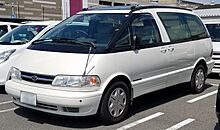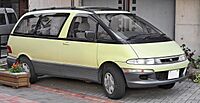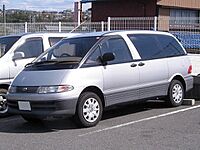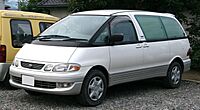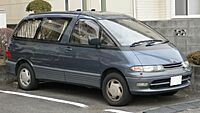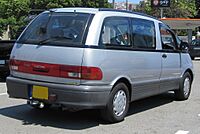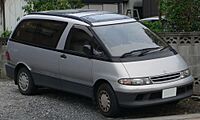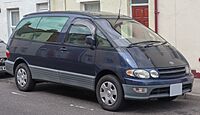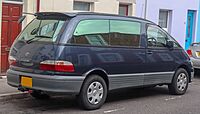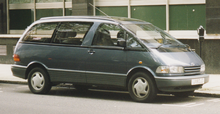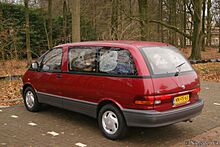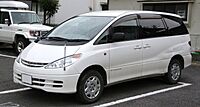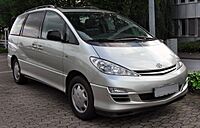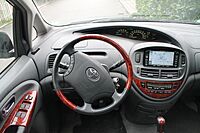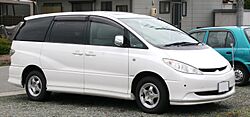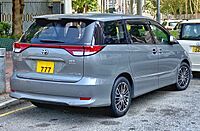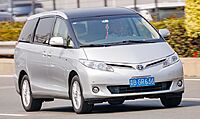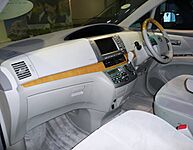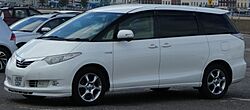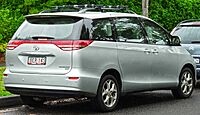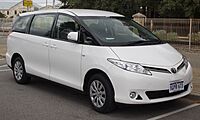Toyota Previa facts for kids
Quick facts for kids Toyota Previa |
|
|---|---|
 |
|
| Overview | |
| Manufacturer | Toyota |
| Also called |
|
| Production | January 1990 – October 2019 |
| Body and chassis | |
| Class | Minivan |
| Body style | 4/5-door minivan |
| Layout |
|
| Chronology | |
| Predecessor | Toyota TownAce/MasterAce Surf (R20/R30) |
| Successor |
|
The Toyota Previa is a type of car called a minivan. It was made by Toyota from 1990 until 2019. In Japan, it was known as the Toyota Estima, and in Australia, it was called the Toyota Tarago.
The name "Previa" comes from a Spanish word meaning "preview." Toyota thought this first Previa would show off new technologies for future minivans. In Japan, the Previa was Toyota's second-largest minivan, after the bigger and fancier Alphard/Vellfire.
Contents
First Generation: The Original Previa (1990)
| First generation (XR10, XR20) | |
|---|---|
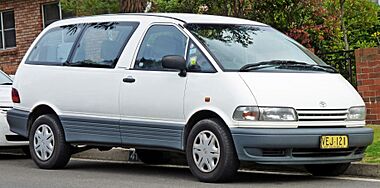
1996–2000 Toyota Tarago GLi (TCR10R, Australia)
|
|
| Overview | |
| Also called |
|
| Production | January 1990 – December 1999 |
| Model years | 1991–1997 (North America) |
| Assembly |
|
| Designer | Tokuo Fukuichi; David Doyle (1987) |
| Layout |
|
| Powertrain | |
| Engine |
|
| Transmission |
|
| Dimensions | |
| Wheelbase | 112.8 in (2,865 mm) |
| Length |
|
| Width | 1,800 mm (70.9 in) |
| Height |
|
| Weight | 1,703 kg (3,755 lb) |
The first Toyota Previa came out on January 27, 1990. It had a unique design where the engine was placed almost flat under the front seats. This clever design helped make the inside of the van very roomy for its size.
The Previa was known as the Toyota Estima in Japan. In the United States and the United Kingdom, it was called the Previa.
Engine and Drive
The first Previa had a 2.4-liter engine. You could get it with either rear-wheel drive or all-wheel drive. All-wheel drive models were called "All-Trac." It came with either a four-speed automatic or a five-speed manual gearbox. This van could seat seven or eight people.
In 1994, a supercharged engine became an option. A supercharger is like a special pump that gives the engine more power. This made the Previa more powerful, going from 135 horsepower to 161 horsepower.
Interior Features
The Previa had a driver and front passenger seat. In the back, there was a three-seat bench that could fold flat. Some versions had two separate captain's chairs in the middle row. These chairs could even swivel to face the back of the van!
The Previa had large windows, giving drivers a great view. Some models even had two moonroofs, one large one over the middle seats and a smaller one up front.
Safety Notes
The Previa was one of the first minivans to meet all US safety rules for passenger cars in 1992. This included having a driver's side airbag. Later models also had a passenger airbag.
Nicknames
Because of its smooth, rounded shape, people sometimes called the Previa "egg vans" or "eggs." In Australia, it was even called a "Wombat" because it looked a bit like the animal.
Global Sales
- Japan: In Japan, there were also smaller versions called the Toyota Estima Lucida and Toyota Estima Emina. These were a bit narrower and shorter. They were made to fit Japan's tax system, which charges less for smaller cars.
- United States: The Previa was sold in the US from 1990 to 1997. It was meant to compete with popular minivans like the Dodge Caravan. However, it was more expensive and had a smaller engine than some rivals. Toyota later replaced it with the Toyota Sienna, which was designed more for the American market.
- United Kingdom: The Previa was sold in the UK starting in 1990. It came in different trim levels like GL, GX, and GS.
- Australia: In Australia, it was called the Tarago. It was sold in different versions, including GLi, GLS, and GLX.
- Estima Emina
- Estima Lucida
Second Generation: A New Look (2000)
| Second generation (XR30, XR40) | |
|---|---|
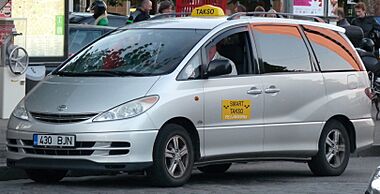
Pre-facelift Previa (Europe)
|
|
| Overview | |
| Also called |
|
| Production | January 2000 – December 2005 |
| Assembly | Japan: Kariya, Aichi (Fujimatsu plant); Toyota, Aichi (Motomachi plant) |
| Designer | Hiroshi Okamoto (1997) |
| Body and chassis | |
| Layout |
|
| Platform | Toyota K platform |
| Related |
|
| Powertrain | |
| Engine | |
| Electric motor | Synchronous motor (hybrid)
|
| Transmission |
|
| Battery | 1.4 kWh nickel–metal hydride |
| Dimensions | |
| Wheelbase | 2,900 mm (114.2 in) |
| Length | 4,750 mm (187.0 in) |
| Width | 1,790 mm (70.5 in) |
| Height | 1,770 mm (69.7 in) |
| Weight | 1,640–1,850 kg (3,616–4,079 lb) |
The second generation Previa came out in 2000. This version was no longer sold in North America, as the Toyota Sienna took its place there.
This new Previa had a slightly longer distance between its wheels. It also changed to a front-wheel drive system, which is more common for minivans. It had sliding doors on both sides for passengers.
Engine Choices
In Europe, you could get the second-generation Previa with either a gasoline or a diesel engine. In Japan, a more powerful 3.0-liter V6 engine was available.
Estima Hybrid: A Green Option
Toyota also made a special Estima Hybrid version. This was a hybrid car, meaning it used both a gasoline engine and electric motors. It was one of the first hybrid minivans in the world! It went on sale in Japan in 2001.
Third Generation: Modern Features (2006)
| Third generation (XR50) | |
|---|---|
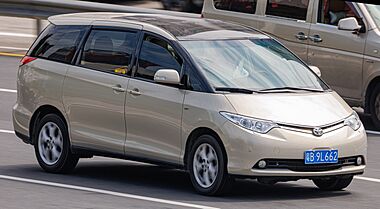
Pre-facelift Toyota Previa (China)
|
|
| Overview | |
| Also called |
|
| Production | January 2006 – October 2019 |
| Assembly | Japan: Kariya, Aichi (Fujimatsu plant); Toyota, Aichi (Motomachi plant) |
| Designer | Kuniaki Toyooka |
| Body and chassis | |
| Layout |
|
| Platform | Toyota New MC platform |
| Related | Toyota Alphard (AH20) |
| Powertrain | |
| Engine | |
| Transmission | |
| Dimensions | |
| Wheelbase | 2,950 mm (116.1 in) |
| Length |
|
| Width |
|
| Height | 1,750 mm (68.9 in) |
| Weight | 1,725–1,915 kg (3,803–4,222 lb) |
The third generation Previa came out in 2006. It was sold as the Estima in Japan and the Tarago in Australia. This version was not available in Europe.
Special Features
This generation offered many cool features. These included:
- An updated hybrid system (in Japan).
- Automatic parking assistance, which helps the car park itself.
- A Lane-Keep Assist system, which helps the car stay in its lane.
- Headlights that turn to light up around corners.
- Reclining seats in the second row with footrests.
- Power-folding third-row seats.
Estima Hybrid: Still Going Green
The third generation also had an Estima Hybrid model. It used Toyota's E-Four hybrid system with all-wheel drive. This hybrid version was mainly sold in China and Japan.
Tarago in Australia
In Australia, the Tarago was updated in 2009 with new headlights and bumpers. It also received a big update in 2016 with a new interior and more standard features. The Tarago was a popular family van and even used as a taxi. In 2019, Toyota stopped selling the Tarago in Australia.
2016 Facelift: Modern Updates
In mid-2016, the Previa/Estima got a refreshed look. It had a redesigned steering wheel and a sleek center console with a large touchscreen.
A new safety system called "Toyota Safety Sense C" was added for Japanese models. This system included features like:
- A pre-collision system that can detect people.
- Lane keep assist to help stay in the lane.
- High beam assist for better night vision.
- Radar cruise control, which keeps a set distance from the car in front.
The updated model also had new headlights with LED daytime running lights and improved tail lights. It was the first Toyota to have special glass that blocks 99% of UV rays, keeping the car cooler inside. This glass even got a recommendation from the Skin Cancer Foundation!



